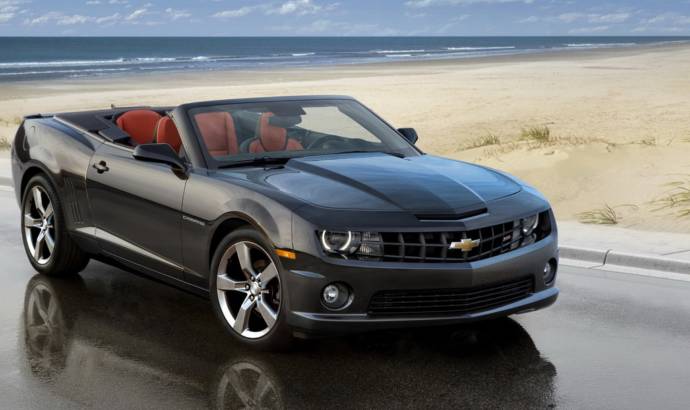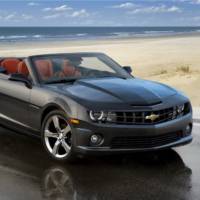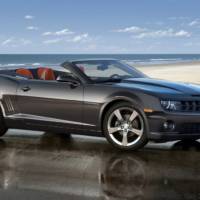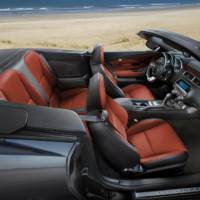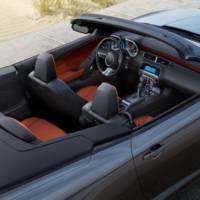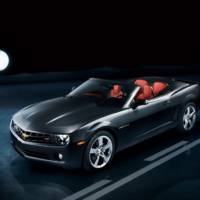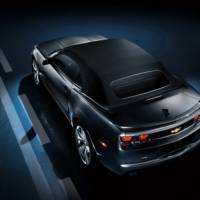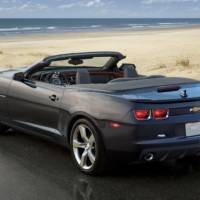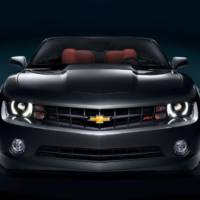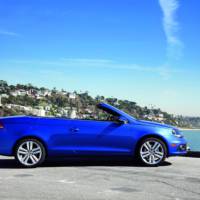As the 2010 Los Angles Auto Show is about to open its doors, GM has officially unveiled the 2011 Chevrolet Camaro Convertible which is scheduled to go on sale in February.
Featuring a series on minor changes that were required by the open top body (relocated antenna and trunk lock cylinder), the 2011 Chevrolet Camaro Convertible is offered with a top made of durable canvas material with a glass rear window that can be lowered in close to 20 seconds by pushing a button.
As you can imagine luggage capacity has been reduced to 290 litres, 222-litres with the roof folded, while under the bonnet the 2011 Chevrolet Camaro Convertible features the entry-level 3.6-litre V6engine delivering 312 HP and 370 Nm of torque that is expected to return 23 mpg combined on the manual equipped version, or 33.5 mpg with the automatic.
The 2011 Chevrolet Camaro Convertible is also available with the more potent 6.2-litre L99 V8 which packs 400 HP and 556 Nm of torque or the 6.2-litre LS3 V8 that spits 426 HP and 569 Nm of torque.
GM press release :
- Camaro Convertible unveiled at Los Angeles Show
- Well-tailored fabric top with acoustical headliner for quietness and easy-to-use single latch
- Robust, reinforced structure supports a sports coupe-like driving experience
- Better torsional stiffness than BMW 3-Series convertible
Chevrolet has lifted the lid on the all-new Camaro Convertible. The
iconic droptop goes into production in January and will reach European
markets, including the UK, later in 2011. It includes an enhanced body
structure and well-tailored top mechanism – a combination designed to
deliver sports coupe-like driving fun and precise quality.
“The launch of the new convertible opens Camaro design and
performance to a new set of potential customers,” said Chris Perry, vice
president of Chevrolet marketing, at the cars unveil at the LA Auto
Show. “The 21st century revival of Camaro is tremendously popular, so
it’s a natural to now expand and elevate the product range in new
directions.”
The convertible will be offered in similar model configurations as
the Camaro coupe. For Europe, that means a 6.2-litre V-8 engine
producing 426 horsepower. A six-speed manual transmission will be
standard, with an optional six-speed automatic.
Camaro is now the best-selling Coupe in its segment in the US market,
and its popularity is backed up by the fact that the right to purchase one of the first convertibles was recently sold at the Barrett-Jackson auction for $205,000,
with all proceeds donated to charity. The 2011 Neiman Marcus Edition
Camaro convertibles, a group of 100 exclusive cars with custom-designed
elements and priced at $75,000 each, sold out in only three minutes.
The Camaro convertible delivers great refinement, along with
uncompromising, coupe-like driving dynamics. Its enhanced body structure
helps prevent cowl or steering wheel shake, for a strong, confident
feel in all driving conditions. The top has a smooth, tailored fit, with
acoustical foam in the headliner that helps deliver a quiet ride with
the top up.
Strong structure
The Camaro’s architecture was designed to accommodate a convertible
model, which means customers enjoy the fun of top-down cruising with
coupe-like driving dynamics. Four strategic reinforcements enhance the
already-stiff body structure to eliminate common convertible maladies of
cowl and steering wheel shake. They include:
- A tower-to-tower brace under the hood
- A transmission support reinforcement brace
- Underbody tunnel brace
- Front and rear underbody “V” braces.
“Our goal in development was to make the convertible match the coupe
as closely as possible in ride quality, handling and overall
performance,” said Al Oppenheiser, Camaro chief engineer.
A telling example of the Camaro convertible’s strength is evidenced
in its suspension tuning – specifically, the lack of changes between the
convertible and coupe models.
“To compensate for the reduced structure of an open car, engineers
often will make the suspension softer, making the convertible a
boulevard cruiser,” said Oppenheiser. “Instead, we took the more
difficult, but better path of bolstering structure rather than softening
the suspension. We didn’t change a strut, bushing or spring rate from
the Camaro coupe.”
The result is a convertible that preserves nearly all the
acceleration, road-holding and performance capabilities of the Camaro
coupe.
Additional safety structural reinforcements are designed to improve
noise and vibration characteristics, while also contributing to the
elimination of cowl/steering wheel shake. They include a hydrofromed
tube in the A-pillars, an inner reinforcement bracket in the windshield
header, a reinforced front hinge pillar and reinforcements inside the
rockers.
The structural changes to the Camaro convertible body give it
superior bending and torsional stiffness than its closest competitor,
and better torsional stiffness than the BMW 3-Series convertible.
Exceptional top refinement
At the outset, designers and engineers sought to eliminate the common
appearance of convertible top support ribs and they succeeded, using
composite knuckles rather than aluminium ones, as well as extending the
top material below the belt line and revising the top’s stitch lines.
The result is a top that has a smooth, taut and carefully tailored
appearance that also retains the sleek roofline of the coupe.
The power-folding top retracts in about 20 seconds. It is built in
partnership with the same manufacturer as the Corvette convertible top,
and operates in a similar manner. That means it folds in a simple “Z”
pattern and latches with a single, convenient handle located at the
center of the windshield header. Other convertible models in this
segment still offer convertible tops with dual latches, forcing drivers
into two-hand operations reaching across the car.
Once the latch is turned to the open position, the push of a single
button lowers the windows and activates the top. The car doesn’t have to
be parked for the top to be activated, allowing for spur-of-the-moment
lowering while stopped at a stoplight.
The top is made of thick, durable canvas and it features acoustical
headliner material that provides a quiet, coupe-like ride when the top
is up. It also incorporates a glass rear window and rear window
defogger.
A folding, one-piece tonneau cover is standard on 2LT and 2SS models
and optional on 1LT/1SS. It covers the folded top for a finished
appearance. An accessory windscreen is available from Chevrolet dealers.
It installs behind the front seats to limit wind buffeting when driving
with the top down.
SPECIFICATIONS (Please note, these refer to US Specification models)
Overview
| Models: | Chevrolet Camaro convertible |
| Body style / driveline: | four-passenger, front-engine, rear-drive convertible |
| Construction: | unitized body frame, one- and two-sided galvanized steel |
| Manufacturing location: | Oshawa, Ontario, Canada |
Engine
| 3 | 6.2L V-8 (LS3, L99) | |
| Type: | 6.2L V-8 | |
| Displacement (cu in / cc): | 376 / 6162 | |
| Bore & stroke (in / mm): | 4.06 x 3.62 / 103.25 x 92 | |
| Block material: | cast aluminium w/ cast-in-place iron bore liners | |
| Cylinder head material: | aluminium | |
| Valvetrain: | overhead valve; two valves per cylinder; roller lifters; Active Fuel Management (L99) | |
| Ignition system: | coil near plug ignition | |
| Fuel delivery: | sequential fuel injection | |
| Compression ratio: | 10.7:1 (LS3); 10.4:1 (L99) | |
| Horsepower (hp / kW @ rpm): |
426 / 318 @ 5900 (LS3)* 400 / 298 @ 5900 (L99)* |
|
| Torque (lb-ft / Nm @ rpm): |
420 / 569 @ 4600 (LS3)* 410 / 556 @ 4300 (L99)* |
|
| Recommended fuel: | premium recommended not required | |
| Maximum engine speed (rpm): |
6200 (L99) 6600 (LS3) |
|
| Emissions controls: | evaporative system, close-coupled catalytic converters, positive crankcase ventilation, electronic throttle control | |
| EPA-estimated fuel economy (city / hwy) US Measurements: |
16 / 25 (auto) 16 / 24 (man) |
|
Chassis / Suspension
| Front: | double-ball-joint, multi-link strut; direct-acting stabiliser bar; progressive-rate coil springs; fully adjustable camber, caster and toe |
| Rear: | 4.5-link independent; progressive-rate coil springs over shocks; stabiliser bar; fully adjustable camber and toe |
| Steering type: | variable-ratio rack-and-pinion |
| Steering ratio: | 16.1:1 |
| Steering wheel turns, lock-to-lock: | 2.5 |
| Turning circle, kerb-to-kerb (ft / m): | 37.7/11.5 |
Brakes
| Type: | four-wheel disc w/ ABS; ventilated front and rear discs; single-piston front callipers and single-piston alloy rear callipers (LS, LT); four-piston fixed Brembo aluminium front and rear callipers (SS) |
| Disc diameter, front (in / mm): | 14 / 355 |
| Disc diameter, rear (in / mm): | 14.4 / 365 |
| Disc thickness, front (in / mm): | 1.26 / 32 |
| Disc thickness, rear (in / mm): | 1.1 / 28 |
Wheels / Tyres
| Wheel size and type: | 20 x 8-inch aluminium (front) 20 x 9-inch aluminium (rear) |
||
| Tyres: | P245/45ZR20 summer (front) P275/40ZR20 summer (rear) |
Dimensions
Exterior
| Wheelbase (in / mm): | 112.3 / 2852 | |
| Overall length (in / mm): | 190.4 / 4836 | |
| Overall width (in / mm): | 75.5 / 1918 | |
| Overall height (in / mm): | 54.7 / 1389 | |
| Track, front (in / mm): | 63.7 / 1618 | |
| Track, rear (in / mm): | 64.1 / 1628 (LT) 63.7 / 1618 (SS) |
|
| Kerb weight (lb / kg): | 3986 / 1808 – LT w/ automatic 3995 / 1812 – LT w/ manual 4168 / 1891 – SS w/ automatic 4116 / 1867 – SS w/ manual |
|
| Weight balance (% front / rear): | 52 / 48 |
Interior
| Seating capacity (front / rear): | 2 / 2 | |
| Headroom (in / mm): | front: 37.8 / 960 rear: 35.7/ 908 |
|
| Legroom (in / mm): | front: 42.4 / 1077 rear: 30 / 760 |
|
| Shoulder room (in / mm): | front: 56.8 / 1444 rear: 42.4 / 1079 |
Capacities
| Convertible | ||
| Cargo volume (cu ft / L): | 10.24 / 290 (top up) 7.85 / 222 (top down) |
|
| Fuel tank (gal / L): | 18.8 / 71.7 | |
| Engine oil (qt / L): | 6.2L: 8.9 / 8.5 |
*SAE certified.
Source: Chevrolet
